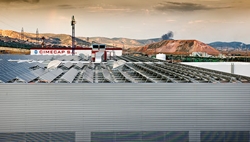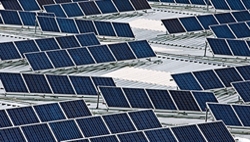Photovoltaic Economics Basic Terms
Some important terms related to photovoltaic system economics are presented herein. The most important PV economic parameters are the total costs of installing a PV system, electricity price, Feed-In tariffs and the energy payback time - EPBT. Investments into renewable energies, particular into PV and wind technologies are another economics related area. The cost of a PV system is measured in price-per-peak-watt (€/Wp or US$/Wp for example). Peak watt is defined as the power at standard test conditions (solar irradiance 1000 W/m2, AM of 1.5 and temperature 25°C). Photovoltaic system costs encompass both module and BOS costs. Module costs typically represents only 40-60 % of total PV system costs. Typically the cost of installing a photovoltaic system having a power of 10 kW was about 1,600 €/kWp and cost of 100 kW was about 1,400 €/kWp in 2013 [1]. In year 2009 for instance typically the cost of installing a photovoltaic system having a power of 1 kW ranges from 3,500 € to 5,000 €/kWp whilst in 2010 average investment decreased to little more than 3,000 €. Approximately about half of this investment would be for the PV modules, and the inverter, PV array support structures, electrical cabling, equipment and installation would account for the rest. Please note that BOS and installation costs can vary significantly. For example: when costs for site preparation, laying a foundation, system design and engineering, permitting, as well as assembly and installation labour are higher, total installation costs are higher too. The life cycle cost (LCC) of a PV system may also include costs for site preparation, system design and engineering, installation labour, permits and operation and maintenance costs. Photovoltaic systems have an anticipated 25-year lifetime.
Due reduced electricty price and lower investment costs are photovoltaic systems
as close to grid-parity as never before
(courtesy:
mstudio)
Energy Payback Time
Energy Payback Time - EPBT is the time necessary for a photovoltaic panel to generate the energy equivalent to that used to produce it. E. Alsema made some interesting EPBT calculations for photovoltaic modules. He estimates 600 kWh/m2 energy produced with monocrystal-silicon modules or 420 kWh/m2 with polycrystalline silicon is used to make near-future, frameless PV systems. Assuming 12 % conversion efficiency (standard conditions) and 1,700 kWh/m2 per year of available sunlight energy, Alsema calculated a payback of about four years for contemporary polycrystalline-silicon PV systems. Projecting 10 years into the future, he assumes a "solar grade" silicon feedstock and 14 % efficiency, dropping energy payback to about 2 years. Some other calculations generally support Alsema's predictions. For amorphous-silicon Alsema estimates that it takes 120 kWh/m2 to make near-future, frameless amorphous-silicon PV modules. He adds another 120 kWh/m2 per frame and support structure (for a rooftop-mounted, grid-connected system). At 6 % conversion efficiency (standard conditions) and 1,700 kWh/m2 per year of available sunlight energy, Alsema calculated a payback of about three years for contemporary thin-film PV systems. Kato and Palz for example calculated even shorter paybacks for amorphous-silicon, each ranging from one to two years. Some links with detailed information about EPBT are available below - for photovoltaic and even for solar thermal systems.
Notes
| [1] | Data source: Bundeswerband Solarwirtschaft. |
General Economic Terms
|
|
IEA: Guidlines for the Economic Analysis of renewable Energy Technology Applications; based on the findings of IEA Workshop on the Economics of Renewable Technologies; Chateau Montebello, Quebec, Canada, 1991. |
|
|
Short W. et al. (1995): A Manual for the Economic Evaluation of Energy Efficiency and Renewable Energy Technologies; National Renewable Energy Laboratory, Golden, CO, A national laboratory of the U.S.Department of Energy managed by Midwest Research Institute for the U.S. Department of Energy, contract No. DE-AC36-83CH10093. |
Energy Payback Time of PV Systems - Papers, Reports
|
|
What is the Energy Payback for PV? NREL, 2004. |
|
|
Ftenakis, V., Alsema, E. (2006), Photovoltaics Energy Payback Times, Greenhouse Gas Emissions and External Costs: 2004–early 2005 Status; Progress in Photovoltaics, Research and Applications 2006; 14:275–280. |
|
|
Knapp, K.E., Jester, T.L. (2000), An Empirical Perspective on the Energy Payback Time for Photovoltaic Modules; Solar 2000 Conference, Madison, WI, 2000. |
|
|
Alsema, E. (1998), Energy Requirements and CO2 Mitigation Potential of PV Systems, Photovoltaics and the Environment, Keystone, CO. Workshop Proceedings, July 1998. |
|
|
Kato, K.; Murata, A.; Sakuta, K. (1998), Energy Payback Time and Life-Cycle CO2 Emission of Residential PV Power System with Silicon PV Module; Progress in Photovoltaics, Research and Applications, 6, 110-115, 1998. |
|
|
Palz, W.; Zibetta, H. (1991), Energy Pay-Back Time of Photovoltaic Modules; International Journal of Solar Energy. Volume 10, Number 3-4, pp. 211-216, 1991. |
Energy Payback Time - Solar Thermal Systems
|
|
Streicher, E. et al.: Energy Payback Time – A Key Number for the Assessment of Thermal Solar Systems; Proceedings of EuroSun 2004, 20 - 23 June 2004, Freiburg, Germany. |
|
|
Drück, H. et al.: Advanced Storage Concepts for Solar Combisystems; Proceedings of EuroSun 2004, 20 - 23 June 2004, Freiburg, Germany. |
Feed-in Tariffs - Literature
|
|
Mendonca, M., Jacobs, D., Sovacool, B.: Powering the Green Economy: The Feed-in Tariff Handbook; Earthscan, 2010, ISBN 978-1-84407-858-5. |
|
|
Mendonca, M.: Feed-in Tariffs: Accelerating the Deployment of Renewable Energy; Earthscan, 2007, ISBN 978-1-84407-788-5. |
|
|
Klein, A.: Feed-in Tariff Designs; VDM Verlag Dr. Mueller e.K., 2008, ISBN 978-3836462389. |
Market prices
Preisindex Photovoltaik - Der Bundesverband Solarwirtschaft lässt quartalsweise Preisdaten für Photovoltaiksysteme erheben. Das Institut EuPD-Research befragt dazu im Auftrag des BSW-Solar repräsentativ 100 Installateure und ermittelt so den Photovoltaik-Preisindex.
PV Insights - PV Insights, a premier international solar PV research firm, helps leading solar PV companies and financial professionals making real time decisions on business strategy, component procurements and investments by insightful reports, advisory service, and efficient price reports.
powerscout - The Costs of Solar Panels for Homes in 2018.
Investments & Finance
Umweltbank - Fonds - und Wertpapierkurse.
GreenValue - auf greenValue finden Sie Beteiligungs- und Investitionsangebote unter anderem aus den Bereichen Photovoltaik, Windkraft, Biogas- und Biomasse, Geothermie und nachhaltiger Forstwirtschaft.
ECOreporter.de - Magazin für Nachhaltiges Investment
Earth Tech Finance - ETF supports international renewable energy (RE) companies and projects in finding capital and advises those enterprises and projects in their development.
A Guide to Green Loans and Energy Efficient Tax Credits - The guide defines specific energy tax credits that individuals and businesses can receive for their green initiatives.
Guide to Green Mortgages - Green, or energy efficient mortgages, let you borrow extra money to pay for energy efficient upgrades to your current home or a new or old home that you plan to buy. The result is a more environmentally friendly living space that uses fewer resources for heating and cooling and has dramatically lower utility costs.
Renewable Energy Policy
DSIRE - The Database of State Incentives for Renewable Energy - the Database of State Incentives for Renewable Energy (DSIRE) is a comprehensive source of information on state, local, utility, and selected US federal incentives that promote renewable energy.
RES LEGAL - the website on legislation on renewable energy generation. Here you will find a collection of and information on the most important legislation on the support schemes and grid access for electricity from renewable sources within the EU 27.
Other Information
|
|
Watt, M.: Added Values of Photovoltaic Power Systems; IEA PVPS Task 1, Report IEA PVPS TI-09, 1997. |
|
|
Wenzl, B., Nitsch, J.: Ausbau erneuerbarer Energien im Strombereich; EEG-Vergütungen, -Differenzkosten und -Umlage sowie ausgewählte Nutzeneffekte bis zum Jahr 2030; Teltow, Stuttgart, December 2008. |
|
|
Nowak, S., Rezzonico, S.: Buy-Back Rates for Grid-connected Photovoltaic Power Systems; IEA PVPS Task 1, Report IEA PVPS TI 1997 2, November 1997. |
|
|
Photovoltaic Deployment in Developing Countries: Financing Mechanisms for Solar Home Systems in Developing Countries; Report IEA PVPS T9-01:2002. |
|
|
Hansen, T. et al.: Photovoltaic Power Plant Experience at Tucson Electric power; ASME International Mechanical Engineering Congress, November 2005, Orlando, FL. |



